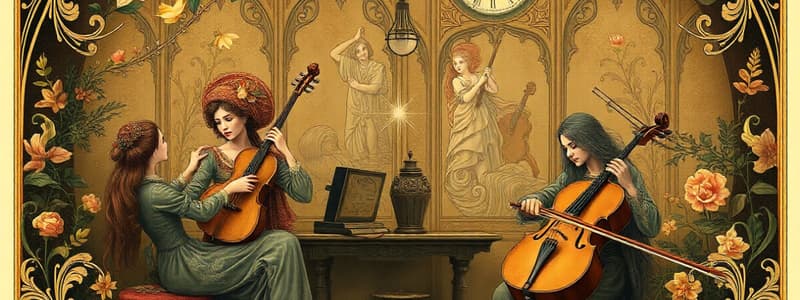Podcast
Questions and Answers
Which classical composer is known for his string quartets and over 100 symphonies?
Which classical composer is known for his string quartets and over 100 symphonies?
- Ludwig van Beethoven
- Johann Sebastian Bach
- Franz Joseph Haydn (correct)
- Wolfgang Amadeus Mozart
The Classical music period emphasized emotional expression over structure and order.
The Classical music period emphasized emotional expression over structure and order.
False (B)
What are the three main sections of the Sonata Allegro Form?
What are the three main sections of the Sonata Allegro Form?
Exposition, Development, Recapitulation
A __________ is a composition for one or more solo instruments and orchestra, with parts of equal importance.
A __________ is a composition for one or more solo instruments and orchestra, with parts of equal importance.
Which term describes a musical form that alternates the main theme with contrasting themes?
Which term describes a musical form that alternates the main theme with contrasting themes?
Match the following composers with their notable works:
Match the following composers with their notable works:
A Scherzo is typically a slow, stately ballroom dance in triple meter.
A Scherzo is typically a slow, stately ballroom dance in triple meter.
What is the term for an improvised passage performed by a soloist, often near the end of a piece?
What is the term for an improvised passage performed by a soloist, often near the end of a piece?
Flashcards
Classical Music Period (1750-1820)
Classical Music Period (1750-1820)
A period in music history characterized by order, objectivity, and proportion, influenced by the aristocracy and advances in science and ideas.
Sonata
Sonata
A common instrumental music form, often with 3 or 4 contrasting movements.
Symphony
Symphony
A long piece of music for orchestra, usually in four movements.
Sonata Allegro Form
Sonata Allegro Form
Signup and view all the flashcards
Concerto
Concerto
Signup and view all the flashcards
Haydn
Haydn
Signup and view all the flashcards
Mozart
Mozart
Signup and view all the flashcards
Diatonic Harmony
Diatonic Harmony
Signup and view all the flashcards
Study Notes
Classical Music (1750-1820)
- Characteristics: Ordered, objective, proportional music reflecting the Age of Reason. Influenced by aristocracy and advancements in science/ideas. Musical patronage was a key aspect.
Classical Music Style
- Melody: Singable and lyrical,
- Harmony: Diatonic (using notes within a key),
- Rhythm/Meter: Regular rhythms and meters,
- Texture: Homophonic (melody with accompaniment).
- Folk Elements: Frequent use of folk elements.
Classical Forms
- Sonata: Multi-movement instrumental composition,
- Theme and Variations: Theme presented, then varied with embellishments,
- Sonata-Allegro Form: Three sections (exposition, development, recapitulation),
- Concerto: Composition for solo instrument(s) and orchestra (equal parts),
- Alberti Bass: Broken chord accompaniment pattern,
- Cantata: Choral work with instrumental accompaniment,
- Rondo: Alternating main theme and contrasting themes,
- Scherzo: Playful or light musical composition,
- Minuet: Slow, stately ballroom dance in triple meter,
- Singspiel: 18th-century German musical comedy (songs and dialogue),
- Symphony: Large orchestra composition, usually four movements,
- Cadenza: Impromptu solo passage (often at piece's end).
Viennese School Composers
- Haydn: Austrian composer, worked for Esterhazy, known for String Quartets and over 100 symphonies (e.g., "Surprise Symphony"),
- Mozart: Austrian composer, child prodigy, freelance later, known for operas ("The Marriage of Figaro," "Don Giovanni"), concertos, symphonies, and sonatas (e.g., "Eine kleine Nachtmusik").
- Beethoven: German composer, famous for symphonies (e.g., 5th in C minor, 9th in D minor), sonatas (e.g., "Moonlight"), concertos, and overtures. Experienced hearing loss.
Studying That Suits You
Use AI to generate personalized quizzes and flashcards to suit your learning preferences.



